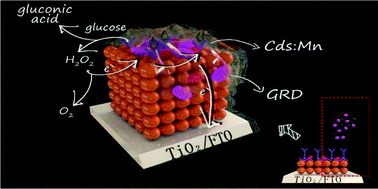Our official English website, www.x-mol.net, welcomes your
feedback! (Note: you will need to create a separate account there.)
A carboxylated graphene nanodisks/glucose oxidase nanotags and Mn:CdS/TiO2 matrix based dual signal amplification strategy for ultrasensitive photoelectrochemical detection of tumor markers
Analyst ( IF 3.6 ) Pub Date : 2017-10-26 00:00:00 , DOI: 10.1039/c7an01453h Jie Song 1, 2, 3, 4 , Shuo Wu 1, 2, 3, 4 , Xinlan Yang 1, 2, 3, 4 , Jingli Yuan 1, 2, 3, 4
Analyst ( IF 3.6 ) Pub Date : 2017-10-26 00:00:00 , DOI: 10.1039/c7an01453h Jie Song 1, 2, 3, 4 , Shuo Wu 1, 2, 3, 4 , Xinlan Yang 1, 2, 3, 4 , Jingli Yuan 1, 2, 3, 4
Affiliation

|
Graphene nanodisks with good conductivity and plenty of edge sites were synthesized to load glucose oxidase (GRD-GOD) and coupled with a Mn2+ doped CdS quantum dot (QD) modified TiO2 electrode (CdS:Mn/TiO2) for a highly sensitive photoelectrochemical (PEC) immunoassay. The specific immune-recognition behaviour can bring the GRD-GOD labelled antigen into the antibody immobilized CdS:Mn/TiO2 interface and dramatically enhance the photocurrent response via a dual signal amplification strategy. First, graphene nanodisks with a strong electron transfer capacity can improve the conductivity of both the insulating protein layers and the CdS:Mn/TiO2 matrix, thus facilitating the regeneration of trapped carriers and hot electrons in the CdS:Mn QD films and enhancing the PEC performance. Second, graphene nanodisks introduce a great number of GOD molecules into a PEC detection process, which catalyze glucose to produce numerous molecules of H2O2. The latter act as sacrificial electron donors to scavenge photogenerated holes, retard the electron–hole recombination, and significantly improve the photo-to-electron conversion efficiency. Based on the dual signal amplification strategy and using a carcinoembryonic antigen as a model target, a highly sensitive PEC immunoassay was therefore developed with an extremely low limit of detection of 5.65 fg mL−1 and a rather wide linear range from 10 fg mL−1 to 1 ng mL−1. The immunoassay showed good reproducibility and stability, as well as good selectivity and high accuracy in serum sample analysis. In this regard, PEC immunosensors may have great application potential for the screening of tumor markers and the prevention and monitoring of serious diseases.
中文翻译:

基于羧基化石墨烯纳米盘/葡萄糖氧化酶纳米标签和Mn:CdS / TiO 2基质的双信号放大策略,用于肿瘤标记物的超灵敏光电化学检测
合成了具有良好电导率和大量边缘位点的石墨烯纳米盘,以加载葡萄糖氧化酶(GRD-GOD)并与Mn 2+掺杂的CdS量子点(QD)修饰的TiO 2电极(CdS:Mn / TiO 2)耦合,以实现高度灵敏的光电化学(PEC)免疫测定。特定的免疫识别行为可以将GRD-GOD标记的抗原带入固定化抗体的CdS:Mn / TiO 2界面,并通过双重信号放大策略显着增强光电流响应。首先,具有强大电子转移能力的石墨烯纳米盘可以提高绝缘蛋白层和CdS:Mn / TiO 2的电导率基质,从而促进了CdS:Mn QD薄膜中捕获的载流子和热电子的再生,并增强了PEC性能。其次,石墨烯纳米盘将大量GOD分子引入PEC检测过程中,该过程催化葡萄糖产生大量H 2 O 2分子。后者充当牺牲电子供体,以清除光生空穴,阻止电子-空穴复合,并显着提高光电子转换效率。因此,基于双重信号放大策略并使用癌胚抗原作为模型靶标,开发了一种高灵敏度的PEC免疫测定法,其检测限为5.65 fg mL -1的极低范围,且线性范围从10 fg mL相当宽-1至1 ng mL -1。免疫测定在血清样品分析中显示出良好的可重复性和稳定性,以及良好的选择性和高精度。在这方面,PEC免疫传感器在筛选肿瘤标志物以及预防和监测严重疾病方面可能具有巨大的应用潜力。
更新日期:2017-11-15
中文翻译:

基于羧基化石墨烯纳米盘/葡萄糖氧化酶纳米标签和Mn:CdS / TiO 2基质的双信号放大策略,用于肿瘤标记物的超灵敏光电化学检测
合成了具有良好电导率和大量边缘位点的石墨烯纳米盘,以加载葡萄糖氧化酶(GRD-GOD)并与Mn 2+掺杂的CdS量子点(QD)修饰的TiO 2电极(CdS:Mn / TiO 2)耦合,以实现高度灵敏的光电化学(PEC)免疫测定。特定的免疫识别行为可以将GRD-GOD标记的抗原带入固定化抗体的CdS:Mn / TiO 2界面,并通过双重信号放大策略显着增强光电流响应。首先,具有强大电子转移能力的石墨烯纳米盘可以提高绝缘蛋白层和CdS:Mn / TiO 2的电导率基质,从而促进了CdS:Mn QD薄膜中捕获的载流子和热电子的再生,并增强了PEC性能。其次,石墨烯纳米盘将大量GOD分子引入PEC检测过程中,该过程催化葡萄糖产生大量H 2 O 2分子。后者充当牺牲电子供体,以清除光生空穴,阻止电子-空穴复合,并显着提高光电子转换效率。因此,基于双重信号放大策略并使用癌胚抗原作为模型靶标,开发了一种高灵敏度的PEC免疫测定法,其检测限为5.65 fg mL -1的极低范围,且线性范围从10 fg mL相当宽-1至1 ng mL -1。免疫测定在血清样品分析中显示出良好的可重复性和稳定性,以及良好的选择性和高精度。在这方面,PEC免疫传感器在筛选肿瘤标志物以及预防和监测严重疾病方面可能具有巨大的应用潜力。











































 京公网安备 11010802027423号
京公网安备 11010802027423号